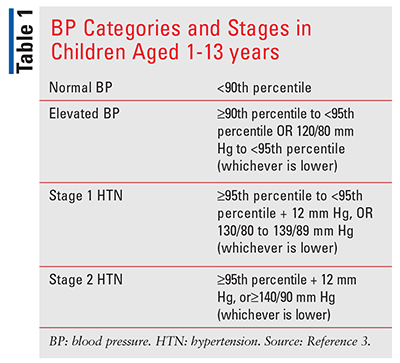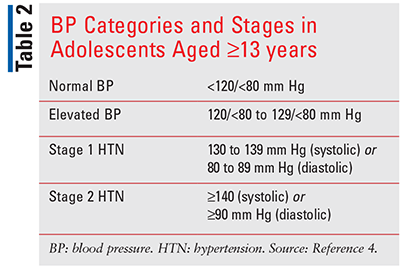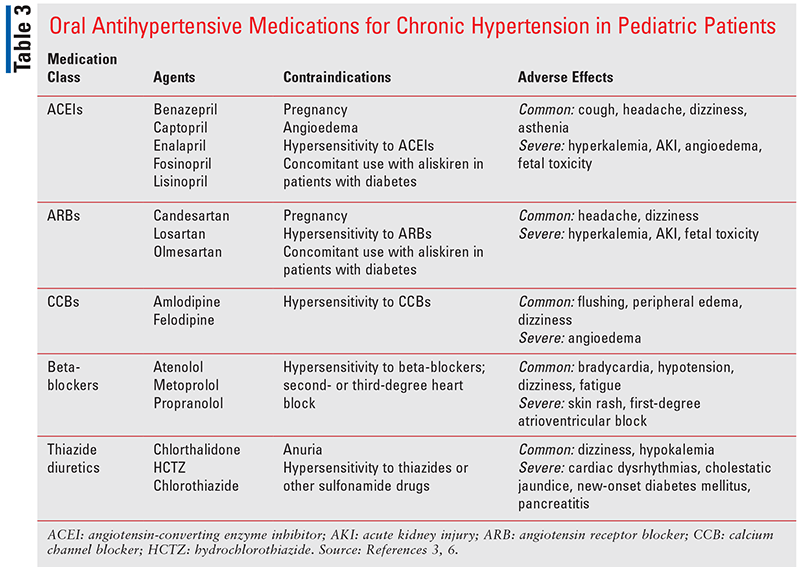US Pharm. 2021:46(8):9-12.
ABSTRACT: Although prevalence of hypertension (HTN) in children and adolescents has decreased, practitioners must remain vigilant in monitoring risk factors such as diabetes and obesity. A timely diagnosis and appropriate treatment can contribute to adult cardiovascular risk reduction. Despite the declining incidence of hypertension, more children and adolescents are classified as having high blood pressure (BP) under new guidelines. The definition of HTN is based on the normal distribution of BP in healthy children. A diagnosis of hypertension can be made in a child or adolescent based on auscultatory BP measurements at three separate visits. Nonpharmacologic treatment should address modifiable risk factors; pharmacologic treatment should be initiated in hypertensive children aged 3 years and older and adolescents who are unresponsive to nonpharmacologic therapies.
Approximately 3% to 4% of children and adolescents in the United States are affected by primary or secondary hypertension (HTN).1 The CDC found that more than one in seven U.S. youth aged 12 to 19 years had high blood pressure (BP) or elevated BP during 2013 to 2016.2 The American Academy of Pediatrics (AAP) released a new guideline in 2017 as an update to the 2004 guideline, which contained new BP category definitions and percentile references.2 From 2001 to 2016, the overall prevalence of HTN actually declined.2 However, when comparing the new and old guidelines, taking into account the new percentile references and a lower threshold for diagnosing HTN, a weighted net estimated increase was calculated, with more patients being reclassified as having HTN using the 2013 to 2016 data.2 HTN rates are higher in children and adolescents with certain chronic conditions such as obesity, with HTN prevalence among overweight and obese youth ranging from 3.8% to 24.8%.3 It is important to address HTN in children and adolescents because higher BP in childhood correlates with higher BP in adulthood.3 Therefore, risks for cardiovascular disease will likely carry into adulthood, ultimately increasing the lifetime risk for heart disease and stroke.2 This article summarizes nonpharmacologic and pharmacologic recommendations to assist pharmacy practitioners in the optimal treatment of HTN in children and adolescents.
Etiology
There are two types of HTN—primary and secondary. Primary HTN is now the more prevalent diagnosis among children and adolescents in the U.S., specifically in children older than age 13 years.1,3 Characteristics or risk factors of children with primary HTN include age 6 years or older, positive family history of HTN (parent and/or grandparent), and overweight and/or obesity.3 Secondary HTN is more common in younger children and is most often caused by renal or renovascular disease.1,3 Other secondary causes include genetic disorders, endocrine disorders, cardiovascular abnormalities, medications, and environmental exposures (e.g., lead).3 Common pharmacologic agents associated with increased BP in children include caffeine, steroids, and decongestants.3
Definition and Classification
The definition of HTN is based on the normal distribution of BP in healthy children and is interpreted based on sex, age, and height in normal-weight youth.3 Fluctuations in BP frequently occur in the first weeks of life, especially in preterm neonates. Consequences of high BP are not well established in neonates and infants up to age 1 year; however, summary tables are available to evaluate BP readings in this population.3 Children and adolescents are classified as having normal, elevated BP (previously known as prehypertension), stage 1 HTN, or stage 2 HTN. The thresholds for adolescents aged 13 years and older now follow the adult guidelines from the American Heart Association and American College of Cardiology, regardless of sex and height.1,4 The specific definitions of HTN in children and adolescents based on age can be found in TABLE 1 and TABLE 2, but for more information on BP levels based on height percentile in boys and girls, refer to the 2017 AAP Clinical Practice Guideline for Screening and Management of High Blood Pressure in Children and Adolescents.3


Diagnosis, Screening, and Symptoms
A diagnosis of HTN can be made if a child or adolescent has auscultatory BP measurements greater than the 95th percentile or higher at three separate visits.3 BP should be measured using the upper right arm at heart level with an appropriately sized cuff.1 The cuff bladder length should encircle 80% to 100% of the arm circumference, with the width being at least 40% of the circumference of the arm.3 The child should be seated with back support and with legs uncrossed in a quiet room for a minimum of 3 minutes before BP measurement is to occur.3 There is no evidence for guidance on the frequency of BP monitoring in children and adolescents.1
In children and adolescents aged 3 to 18 years who do not have HTN or are asymptomatic, the 2020 U.S. Preventive Services Task Force (USPTF) concluded that there is insufficient evidence to recommend for or against screening for high BP.1 This recommendation statement endorses monitoring for signs and symptoms of high BP and conducting further evaluation if necessary.1 In contrast to the USPTF recommendation, the AAP supports BP measurement at well-child visits for children aged 3 years and older.3 The AAP advocates that BP be measured annually in otherwise healthy children. Children with obesity, renal disease, diabetes, aortic arch obstruction or coarctation, or patients taking medications that increase BP should have a BP measurement recorded at each healthcare encounter.3
Nonpharmacologic Treatment
In children aged 3 years and older with primary HTN, nonpharmacologic therapies should be implemented first to address modifiable risk factors.1,3 When treating children with primary or secondary HTN, the goals of nonpharmacologic and pharmacologic treatment should include achieving a reduction in BP to a level that prevents target end-organ damage as well as the risk of cardiovascular disease or HTN in adulthood. More specifically, the goal is to reduce BP to lower than the 90th percentile or less than 130/80 mm Hg in those who are aged 13 years and older.3 The guidelines recommend that perinatal, past medical, nutritional, activity, and psychosocial histories be obtained to assist in evaluation and treatment.3
There are three nonpharmacologic strategies currently listed in the guidelines for treating HTN in the pediatric population. These strategies include diet, physical activity, and stress reduction.3 The Dietary Approaches to Stop Hypertension diet is used to decrease HTN in both adults and children and has been proven efficacious. This diet emphasizes high intake of fruits, vegetables, whole grains, nuts, and low-fat dairy products; it is low in sodium, highly processed foods, and sugar.3
Along with diet modification, exercise has been shown to reduce systolic BP in obese children and adolescents by an average of 6.6 mm Hg in a review of several physical-activity intervention studies.5 Although listed as a weak recommendation in the AAP guideline, children and adolescents can be encouraged to participate in moderate to vigorous activity for at least 30 minutes 3 to 5 days a week.3 Any type of exercise can be beneficial, whether it be aerobic exercise, resistance training, or a combination.3
Patients with stress-related BP elevations may be educated on stress-management techniques, including deep breathing, meditation, and yoga, although limited supporting evidence exists.3 Motivational interviewing may be an effective tool for intervention with patients who are diagnosed with overweight or obesity.3
BP monitoring at home is also encouraged to assess control after HTN has been diagnosed and as a supplement to office BP measurement.3 The patient and the patient’s caregivers should be counseled on how to correctly measure BP, and to keep a log of BP readings.3 Nonpharmacologic therapy should be continued in children requiring pharmacologic therapy, and patients maintained on lifestyle modifications should be seen in the office every 3 to 6 months.3
Pharmacologic Treatment
Pharmacologic therapy should be initiated in hypertensive children and adolescents who are unresponsive to nonpharmacologic therapies. Pharmacologic therapy should also be initiated as first-line therapy in patients who have symptomatic HTN; stage 2 HTN without a modifiable risk factor (e.g., obesity); or any stage of HTN associated with chronic kidney disease (CKD) or diabetes.3 Monotherapy and using a dose at the low end of the dosing range are recommended.3 First-line treatment options include angiotensin-converting enzyme (ACE) inhibitors, angiotensin receptor blockers (ARBs), long-acting calcium channel blockers, and thiazide diuretics. In patients with HTN and CKD, proteinuria, or diabetes mellitus, ACE inhibitors and ARBs are considered first-line agents unless there is a contraindication (see TABLE 3).3,6

Beta-blockers are not recommended as initial therapy in children due to undesirable adverse effects and lack of improved outcomes in adults when compared with other treatment options.3 A higher initial dose of ACE inhibitors in African American children may be considered, as this population may not respond well to typical starting doses. In addition, a long-acting calcium channel blocker or a thiazide diuretic can also be considered as first-line treatment options in pediatric patients who are of African American descent.3 Patients who require pharmacologic therapy to manage their HTN should be encouraged to continue lifestyle modifications such as exercise and a healthy, low-sodium diet.
Medication dosing should be guided by the patient’s BP readings. The dose of the initial medication can be increased ever y 2 to 4 weeks until BP control is achieved, the maximum dosage is reached, or until the patient experiences adverse effects.3 In general, patients should be seen every 4 to 6 weeks until BP has normalized.3 Once BP is controlled, follow-up appointments may occur every 3 to 4 months.3
A second agent can be added to the regimen and titrated if an inadequate response occurs with a single agent. The preferred second agent is a thiazide diuretic, owing to the salt and water retention that often occurs from the other first-line agents.3 In cases where children appear to have a lack of response after treatment with two or more antihypertensive agents, medications such as alpha-blockers, beta-blockers, combination alpha- and beta-blockers, centrally acting agents, potassium-sparing diuretics, and direct vasodilators can be considered.3 A few cases of treatment-resistant HTN have been reported in children, but unlike adults, these cases are often due to undiagnosed secondary causes.7 Apparent resistant HTN of childhood is defined as poorly controlled BP on two or more optimally dosed medications.7
Pharmacist’s Role
Pharmacists can assist in the management of HTN in children and adolescents by recommending appropriate screening, monitoring trends in BP changes, discussing lifestyle modifications, and recommending the appropriate first-line medications. Given the risk for future cardiovascular events as an adult if HTN is left untreated and the growing obesity problem in our country, pharmacists can intervene early by providing education and partnering with pediatric patients, their caregivers, and other practitioners.
The content contained in this article is for informational purposes only. The content is not intended to be a substitute for professional advice. Reliance on any information provided in this article is solely at your own risk.
REFERENCES
1. Screening for high blood pressure in children and adolescents: U.S. Preventive Services Task Force Recommendation Statement. JAMA. 2020;324(18):1878-1883.
2. Jackson SL, Zhang Z, Wiltz JL, et al. Hypertension among youths—United States, 2001–2016. MMWR Morb Mortal Wkly Rep. 2018;67:758-762.
3. Flynn JT, Kaelber DC, Baker-Smith CM, et al. Clinical practice guideline for screening and management of high blood pressure in children and adolescents. Pediatrics. 2017;140(3):e20171904.
4. Whelton PK, Carey RM, Aronow WS, et al. 2017 ACC/AHA/AAPA/ABC/ACPM/AGS/APhA/ASH/ASPC/NMA/PCNA guideline for the prevention, detection, evaluation, and management of high blood pressure in adults: a report of the American College of Cardiology/American Heart Association Task Force on Clinical Practice Guidelines. J Am Coll Cardiol. 2018;71:e127-e248.
5. Torrance B, McGuire KA, Lewanczuk R, McGavock J. Overweight, physical activity and high blood pressure in children: a review of the literature. Vasc Health Risk Manag. 2007;3(1):139-149.
6. Metoprolol. In: Pediatric & Neonatal Lexi-Drugs. Hudson (OH): Lexicomp Inc.: updated June 9, 2021. Available from: http://online.lexi.com. Accessed June 9, 2021.
7. Macumber I, Flynn JT. Does treatment-resistant hypertension exist in children? A review of the evidence. Pediatr Nephrol. 2020;35(6):969-976.
To comment on this article, contact rdavidson@uspharmacist.com.





